This library contains the full sample content of the previously available BBO Packs Andromeda (Tutti Essentials), Altair (Section Essentials), and Black Eye (Tutti Phrases & FX). The comprehensive collection places all orchestral power at your fingertips.
The Precision Presets discussed in this document are what you already know if you own other VSL libraries. As opposed to our new Flow Presets, they allow you to explore the depths of the library, adjusting and tweaking parameters as you see fit. Here you can also create presets of your own and adapt them to your workflow.
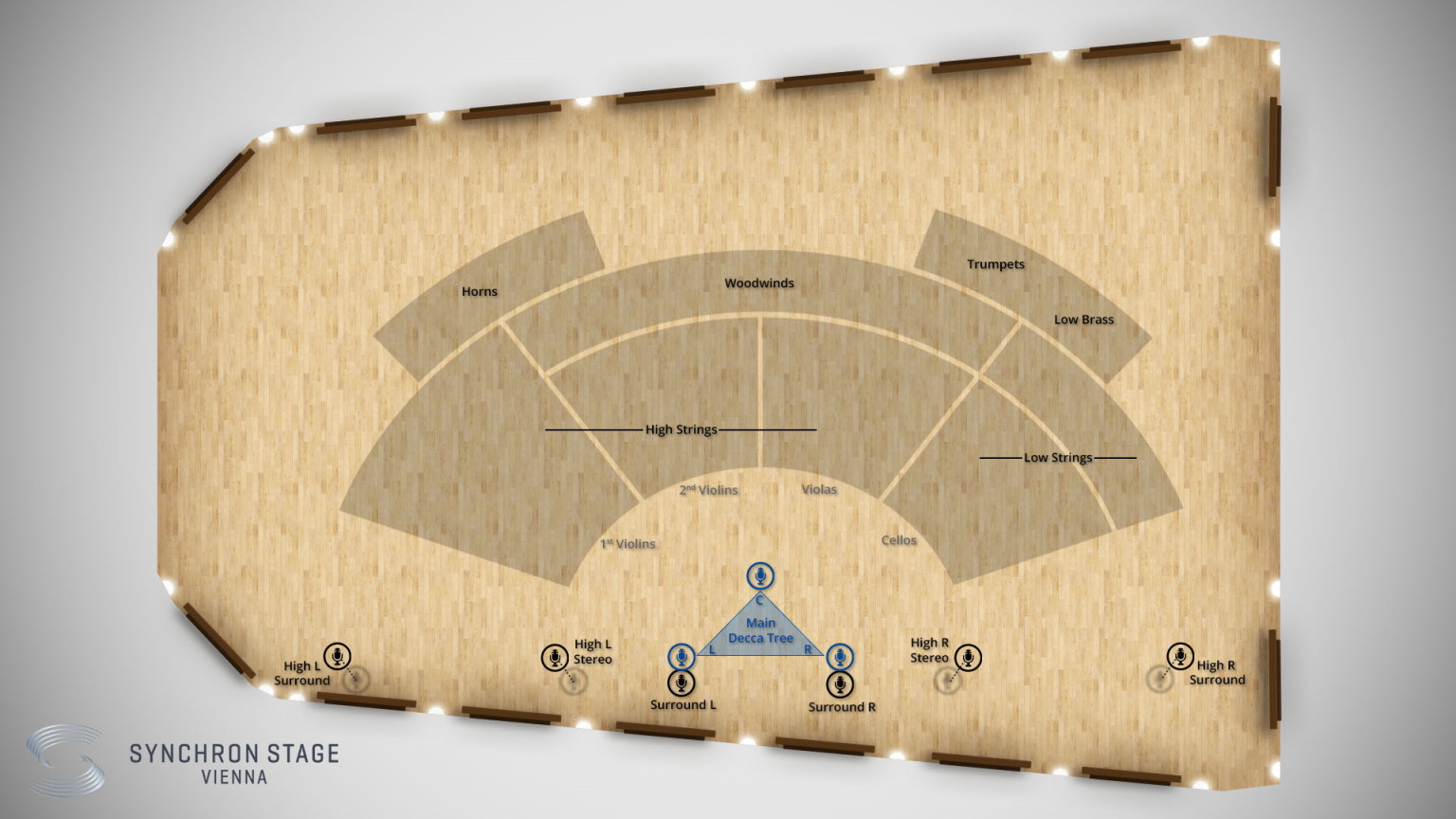
The collection features the individual sections of the orchestra as well as their different combinations, in three groups of presets: a version marked 'Velocity' without velocity crossfading via controller, one with velocity crossfading marked 'VelXF' in its name, and one marked 'VelXF sus' where velocity crossfading is only activated for long notes, while the dynamics of short notes are controlled by keystroke velocity, thus facilitating phrasing. Velocity crossfading can always be enabled or disabled by clicking its on/off symbol in the Synchron Player's Perform tab.
Articulations: The available articulations for every section are short notes in bold and agile variants, long notes, and marcato
Range: All Articulations range from A#1 to D6
Section keyswitches: C7–F7
Articulation keyswitches: C1–D1
Short notes bold/agile: A0/B0
Strings, woodwinds, and brass ensembles: tutti, single, and in combinations of strings and woodwinds, strings and brass, woodwinds and brass: short notes, long notes, and marcato.
Range: A#1–D6
Section selection: C7–F#7
Articulation: C1–D1
Bold/agile: A0/B0
The tutti and individual sections of strings, woodwinds, and brass have three articulations. The short notes can be switched between bold and agile playing with A0/B0.
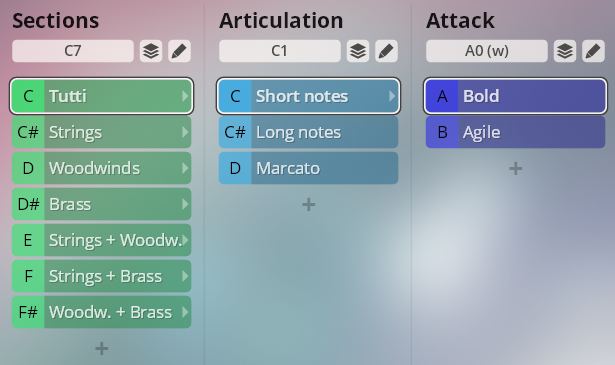
The three combinations – strings and woodwinds, strings and brass, and woodwinds and brass, have a third column of slots showing the two stacked sections. There are no additional keyswitches.

Tutti articulations with and without piccolo flute: short notes, long notes, dynamics, tremolo and trills, half tone falls, and fast repetitions. All except the short notes have a marcato attack option.
Range: A#1–D6
Senza/con piccolo: A0/B0
Articulation: C1–F1
Marcato: G1/A1
Marcato attack: Dim.Ctrl/A, keystroke velocity

Normal, soft low brass, espressivo, soft swell, sforzato, sforzatissimo. The amount of marcato attack is controlled by keystroke velocity.
Type: C7–F7
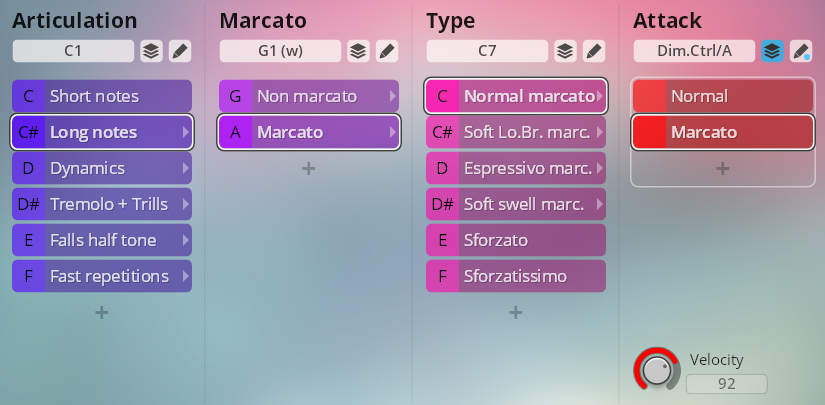
Swells short and long.
Type: C7/C#7
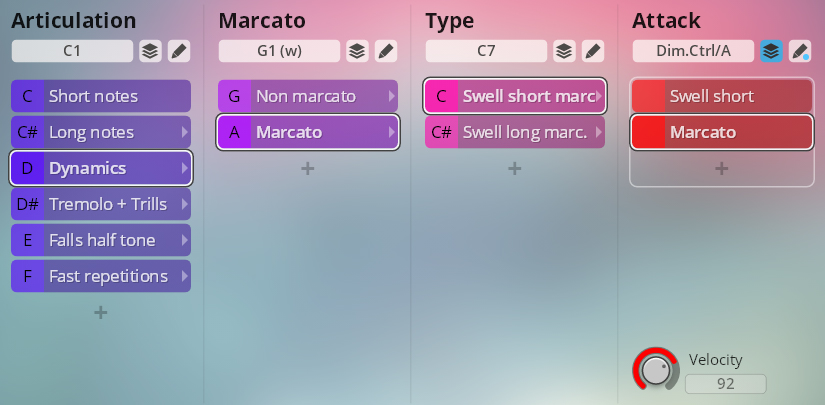
Tremolo normal, half and whole tone trills.
Type: C7–D7

Half-tone falls, regular and with marcato option.
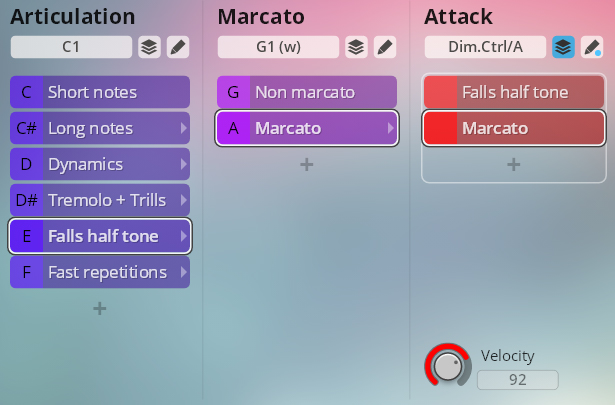
Fast repetitions at 120/140/150 bpm.
Repetition speed: C7–D7

Played con sordino: short notes, long notes, soft swell, tremolo, trills. With marcato attack option except short notes.
Range: C2–D6
Articulation: C1–D#1
Marcato: G1/A1
Marcato attack: Dim.Ctrl/A, keystroke velocity
Long notes normal and espressivo.
Type: C7/D7
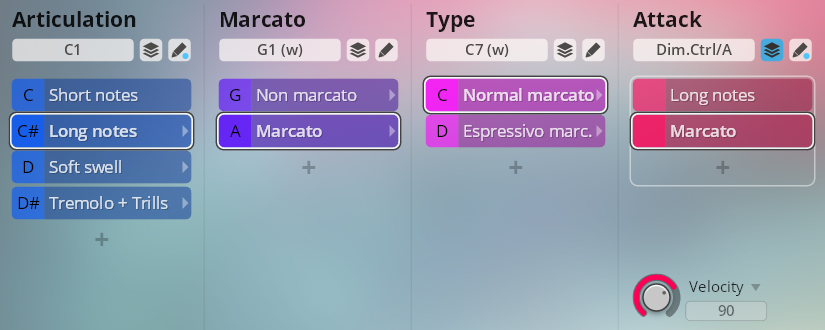
Soft swell with marcato option.

Tremolo/flutter normal, half and whole tone trills.
Tremolo/trill: C7–D7
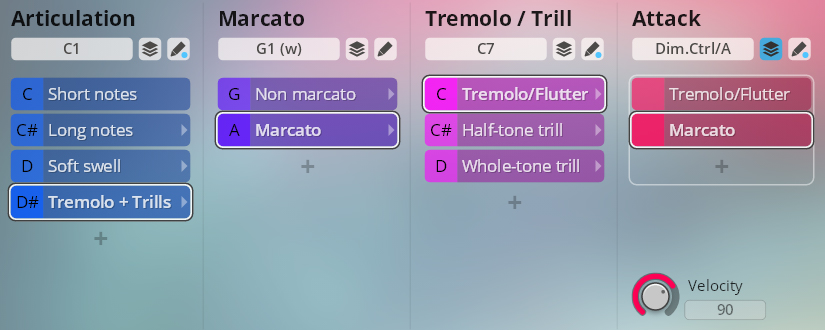
Unison hits, chords, runs and rips, phrases and effects, clusters A and B, and special clusters.
Category: A0–B0 Hits / Phrases & FX / Clusters
Subcategory: C1/C#1 Unison hits / Chord hits
Unison hits
Flams are basically grace notes played very close together (the first one soft, the second at normal volume) in order to sound like one slightly longer note.
Delayed means that the lower or higher registers of the sound set in slightly later than their opposites.
In the Graced patch, the instruments of the high register rip towards a target note, which is reinforced by the rest of the orchestra with a powerful marcato-staccato.
With pp sustain provides a fortississimo staccato of brass and low strings, of which a very soft high note played by the muted strings remains.
Range: flams A#1–D5; others A#3–D5
Articulation: D#1–G#1
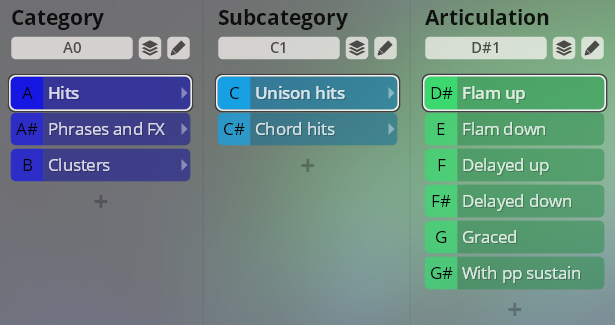
Chord hits
Major, minor, open, and diminished chord hits.
Range: A#3–D5
Articulation: D#1–F#1
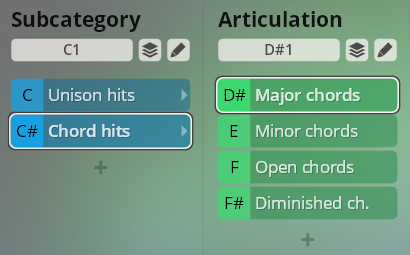
Runs and rips, and phrases and FX.
Subcategory: C1/C#1 Runs and rips / Phrases and FX
Runs and rips
Major and minor octave runs up and down, rips (powerful glissandos to the beginning of a note) up and down.
Range: runs A#1–D5; rips C2–D6
Articulation: D#1–G#1
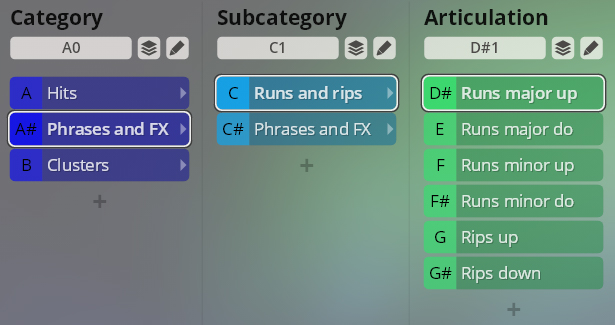
Phrases and FX
This category contains various sustained textures.
Volume pumping does what it says – the sound’s volume swells and abates.
Shuffled sustain is a kind of controlled chaos, where different groups of the orchestra play complementary rhythmic patterns. Due to its complex structure, this effect can be used independently of tempo and provides a propelling density that lends itself well to underscores, for instance.
Microtuning comes in slow and fast variants, with the pitch of instruments hovering around the target note.
Echoes repeats the initial sound at a lower volume while keeping up the sustained note.
Octave trills are just that – instrument groups playing trills in octaves.
Seagull arpeggio is an effect created by flageolet glissandos played on open strings, with the accompanying wind instruments playing arpeggios that follow the overtone series of the strings.
Range: pumping, microtuning A#1–D6; shuffled A#2–D5; echoes, arpeggio A#3–D5; trills A#1–D5
Subcategory: C1/C#1 Runs and rips / Phrases and FX
Articulation: D#1–A1
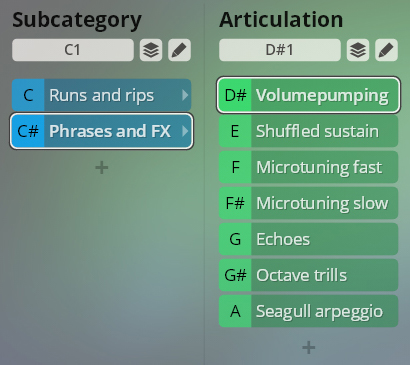
Clusters A and B, and special clusters.
Subcategory: C1–D1 Clusters A/B/Special
Clusters A and B
The “regular” clusters come in two variants marked “A” and “B”, respectively. Both of them have the same low range sounds, with the variants in the high ranges. The clusters comprise short notes, long notes, and short and long swells (sounds increasing continuously in volume and ending abruptly at the peak). All long articulations have a velocity-controlled marcato attack variant.
Range: low clusters mapped to A#1–D4; clusters A/B to A#4–D6
Articulation: D#1–A1
Marcato attack: Dim.Ctrl/A, keystroke velocity
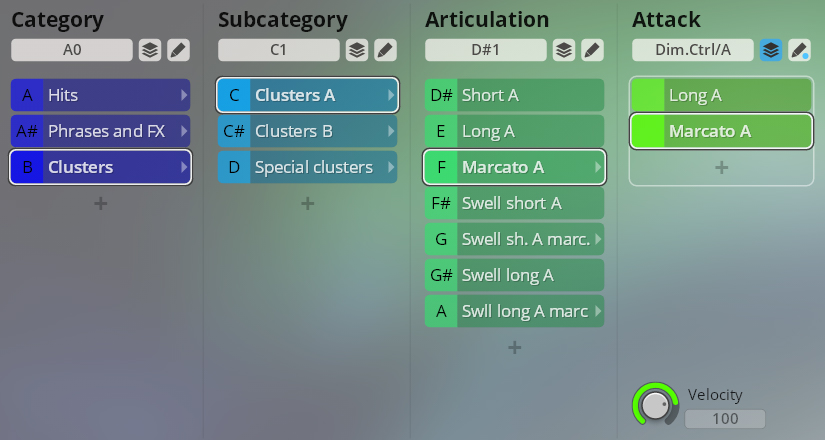
Special clusters
Cluster to root offers sounds that start out from a cluster, with the instruments gradually coming together at the target note.
Root to cluster does the opposite – the tones deviating more and more from the original root note.
Hits + pp sustain starts with fortississimo staccato clusters of brass and low strings, out of which emerge very soft higher-range clusters played by the muted strings.
Range: cluster to root, root to cluster A#1–D6; hits A#3–D5
Articulation: D#1–F1
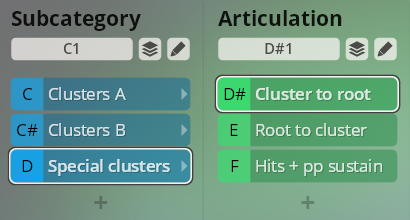
Runs major and minor, clusters var. A and B.
Major and minor runs, up and down.
Range: A#1–D5
Articulation: D#1–F#1

The “regular” clusters come in two variants marked “A” and “B”, respectively. Both of them have the same low range sounds, with the variants in the high ranges. The clusters comprise short notes, long notes, and short and long swells (sounds increasing continuously in volume and ending abruptly at the peak). All long articulations have a velocity-controlled marcato attack variant.
Range: low clusters mapped to A#1–D4; clusters A/B to A#4–D6
Var. A/B: C1/C#1
Articulation: D#1–A1
Marcato attack: Dim.Ctrl/A, keystroke velocity
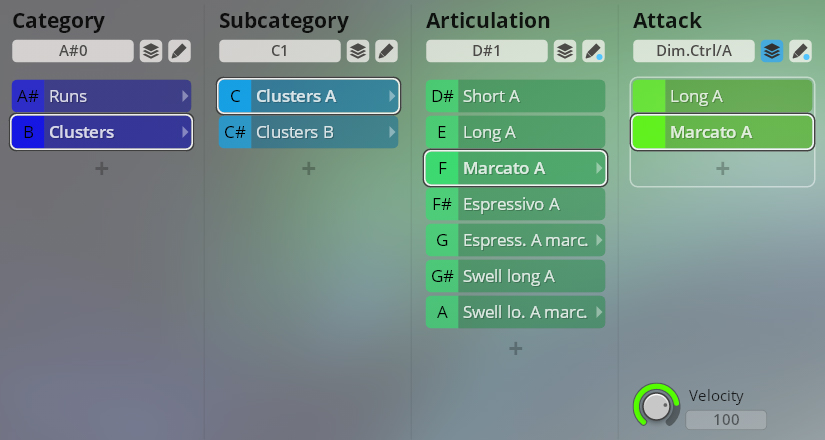
On this page
- Introduction
- Included Presets
- Section Essentials
- Tutti and individual sections
- Ensemble combinations
- Tutti Essentials
- Long notes
- Dynamics
- Tremolo + trills
- Falls half tone
- Fast repetitions
- Tutti con sordino Essentials
- Long notes
- Soft swell
- Tremolo + trills
- Tutti Phrases & FX
- Hits
- Phrases and FX
- Clusters
- Tutti sordino Runs & FX
- Runs
- Clusters A and B